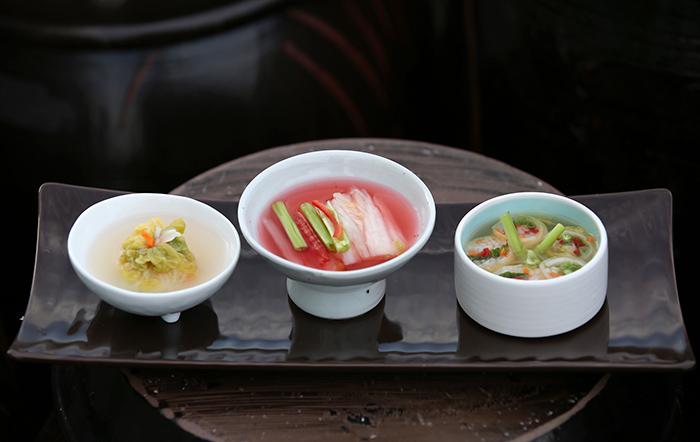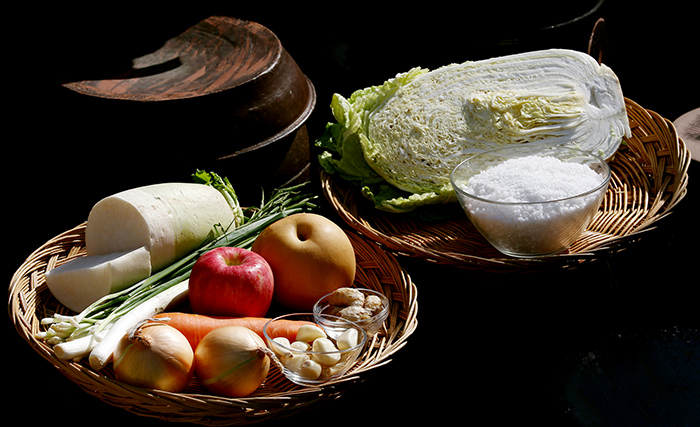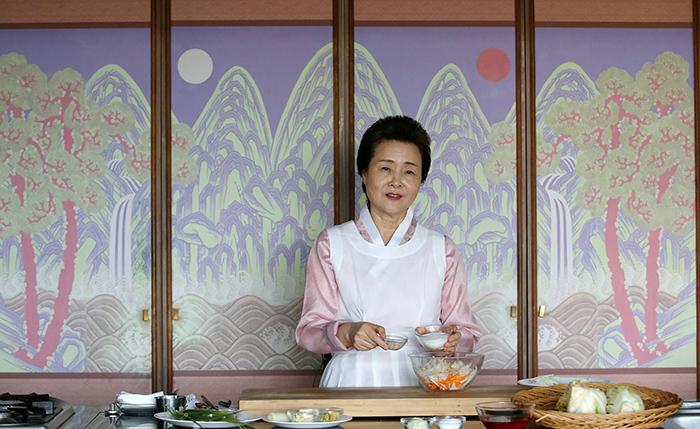| Six government organizations, including the Korean Food Promotion Institute, formerly known as the Korean Food Foundation, and the Ministry of Culture, Sports and Tourism, introduced their “10 Korean Recipes Loved Around the World” in September 2016, targeting non-Korean tourists who will visit Korea for the PyeongChang 2018 Olympic and Paralympic Winter Games. The aim is to help tourists enjoy Korean cuisine and widen their understanding of Korean culinary heritage. The 10 selected dishes constitute a Korean menu that contains the essential identity of Korean cuisine, while improving each dish's individual taste, convenience and appearance. |
By Yoon Sojung
Photos = Jeon Han
Video = Kim Sunjoo
In cooperation with the Institute of Traditional Korean Food

Triple white kimchi uses white kimchi, which is characterized for its light, clear and crunchy taste. It's called 'triple' because the dish prepares white kimchi three different ways: as a roll, as a pouch and as a salad.
The New York Times has dubbed kimchi as “Korean soul food,” an inseparable dish in Korean culinary heritage.
When thinking of the dish, many people think of red spicy cabbage kimchi. However, white cabbage kimchi without any chili peppers is much closer to the traditional forms of the fermented vegetable side dish.
Records of traditional kimchi recipes can be found in various ancient books. One such record is found in the "Dongguk Isang Gukjip" (동국이상국집, 東國李相國集). Author Yi Gyu-bo (이규보, 李奎報) (1168-1241) was a renowned literary servant and scholar from Goryeo times (918–1392). In his book, the author writes about kimchi made from salted radish, mustard, garlic and ginger. Chili peppers didn't come to Korea until after the Japanese invasions of Korea in the 1590s, the Imjin Waeran (임진 왜란, 壬辰 倭亂, "Battles in the Year of Imjin") (1592-1598).
Generally, kimchi cabbage is one of the most important ingredients that goes into cabbage kimchi.
Many people prefer kimchi cabbage grown in cooler areas of Gangwon-do Province according to Director Yoon Sook-ja of the Institute of Traditional Korean Food. This is because, Yoon says, “Kimchi cabbage produced in the cooler areas of Gangwon-do Province area are crunchier and they don't get that soft when compared to other types of cabbage produced elsewhere.”
Regarding this triple white kimchi recipe, Director Yoon says that, “White kimchi also wins popularity as a salad among non-Koreans. You can also use any other cabbage instead of kimchi cabbage.”
** Recipe for triple white kimchi
** Ingredients (four servings)
white cabbage 1 (2.5kg), coarse salt 2.5 cups (350g), water 10 cups (2L)
apple 1 (250g), pear 1 (560g), onion 2 (300g), radish 300g, carrots 200g, red chili 1, water parsley 10g, dried omija berries 10g
kimchi stuffing marinade: fine salt 1 tablespoon (13g), sugar 1 cup (160g), salted shrimp 50g
fragrant leaves: sliced green onions (the white part) 50g, shredded ginger 20g, shredded garlic 40g
fine salt 3 tablespoons (39g), dried yellow pollack stock 3L small green onion 30g

The main ingredients in triple white kimchi are cabbage, raddish, carrots, green onions, onion, ginger, garlic and salt.
** Instructions
1. Remove the bottom part and outer leaves of the cabbage head and split it in half.
2. Place the cabbage into salted water with the cut surface facing upward. Let it sit for 6 to 8 hours.
3. Thinly slice the carrots, pear, radish and onion. Add the sugar and salted shrimp. Mix well.
4. Add the sliced green onions, shredded ginger and onion to make the kimchi seasoning.
5. Mix the seasoning with the cabbage by placing the ingredients in each layer of cabbage leaf. Wrap the stuffed cabbage with the outer leaves.
6. Place a cotton cloth containing the shredded ginger, garlic, fragrant vegetables and chili pepper into a large jar of dried yellow pollack stock. Leave the stock for 1 or 2 days at room temperature. (Dried yellow pollack makes the stock tastier, but it can be omitted if you cannot find it.)
7. Cut broad leaves of the fermented kimchi into half. Place the kimchi seasoning on the leaves.
- White kimchi lucky pouch: Shape each leaf into a small pouch. Wrap it up and tie it closed with the water parsley leaves.
- White kimchi roll: Place the green onions, red chili peppers and onions on the fermented cabbage leaves. Roll the leaves and cut them into bite-sized pieces.
- White kimchi salad: Put the bite-sized kimchi leaves in a bowl. Add the water parsley and red chili peppers as a garnish. Add the white kimchi broth mixed with kimchi stock and omija berry water.

Director Yoon Sook-ja of the Institute of Traditional Korean Food prepares a kimchi stuffing with shredded vegetables, carrots, radish, salt and salted shrimp.

Place a cotton cloth containing the shredded ginger, garlic, fragrant vegetables and chili pepper into a large jar of dried yellow pollack stock. Put the stuffed cabbage in the jar filled with kimchi stock and leave it for 1 or 2 days at room temperature. Dried yellow pollack makes the stock tastier. Fruit can be also added.
arete@korea.kr
Most popular
- Grammy-winning producer calls Suga of BTS 'amazing artist'
- 'Universal love, family' themes fuel success of 'King of Kings': director
- Council sets minimum hourly wage in 2026 at KRW 10,320
- Expansion of foreign app system raises tourist convenience
- Nat'l population diversity rose nearly 8% from 2018-22: study
